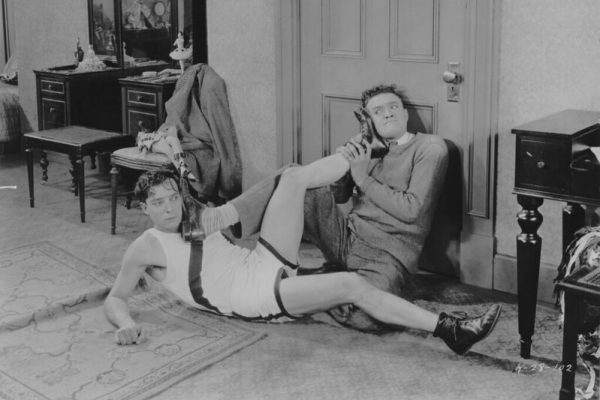Eureka’s third collection of Buster Keaton’s films lacks any of the great man’s most beloved works, but no one (with one glaring caveat detailed later) will be disappointed by these three silent classics. Not only do the movies contain some of Keaton’s most daring, and hilarious, stunts, but they ably mark his progress as a filmmaker. By 1927, he was, in Roger Ebert’s estimation: “… arguably, the greatest actor-director in the history of the movies.”
The earliest film in the collection is Our Hospitality, a parody of the famous long-running Old West feud between the Hatfield and McCoy clans. In this version, Keaton’s Willie McKay falls for Virginia Canfield (Keaton’s wife Natalie Talmadge) during a long train journey to claim the property left to him after the death of his father. Virginia invites Willie to the Canfield home, where the men of the house discover his identity, putting him in mortal danger. Thanks to a self-imposed code of honour, however, the Canfields can’t kill Willie while he is a guest in their home, which leads to the desperate young man going to extreme lengths not to leave the property.
Our Hospitality (co-directed with John G. Blystone) was Keaton’s first full-length narrative feature (his earlier film Three Ages was more of an anthology) and it is fair to say he was still adapting to the pacing of the long-form picture. The first 30 of the film’s 77 minutes is taken by the train ride from New York to Appalachia, which is evidence of Keaton’s growing technique as a director and editor but means the narrative proper is an exercise in delayed gratification. To be fair though, if you go to the expense of getting a working replica of Stephenson‘s Rocket for your film, you may as well get the full usage.
Once in the Canfield home, this dicey comedy of manners quickly escalates, culminating in an extraordinary stunt in which Keaton swings out like a pendulum to catch Talmadge as she plunges over a waterfall. The pregnant Talmadge was swapped out for a dummy, but the rest is all Keaton. Fittingly for a film dealing with family, Our Hospitality was a multi-generational affair. Along with Talmadge, Keaton’s father Joe appears as the train’s engineer, while Buster Keaton Jr. plays Willie as a baby.
Go West is a modern western in which Keaton’s lonesome cowboy Friendless becomes bosom buddies with a cow called Brown Eyes (playing herself, according to the credits). Friendless could be seen as a riff on Chaplin‘s Little Tramp persona – a hapless drifter who gets swept like driftwood into all manner of scrapes.
This 1925 effort has the most complete narrative of the three films, with a character that suits Keaton’s heavy-lidded melancholy to perfection. His equine and bovine costars often dwarf the diminutive comic, making his every abortive task on the cattle ranch seem like a genuine risk and increasing the sense of isolation around the character. Keaton channels the pathos into the comedy, with some of the smaller moments being the finest. Particularly memorable are Friendless patiently, cluelessly waiting for Brown Eyes to milk herself, and a running gag in which he frequently has to fish a tiny Derringer from a full-size holster.
It’s a movie of little gold nuggets that climaxes with a satisfying grand finale involving herds of cattle causing havoc in downtown Los Angeles, and Buster saving the day dressed in a Devil outfit. Sweetly, he also gets to drive off with his leading lady.
1927’s College ( with James W. Horne credited as co-director) came after the baffling critical and commercial failure of The General and features a stripped-back story that is almost entirely a showcase for Keaton’s physical prowess. He plays, ironically, a bookish milquetoast who loses his girlfriend (Anne Cornwall) to a sporty rival (Harold Goodwin). He tries his hand at every sport in an attempt to win her back, before finding his niche as a rowing cox.
The extended track and field sequence is a brilliant example of Keaton, to quote Eric Morecambe, ‘playing all the right notes in the wrong order‘. It’s a masterclass of physicality being used to disguise phenomenal athletic prowess. Small though Keaton was, there was no disguise that he was all wire and sinew when in his sports gear. The skill is there to see in a sequence where he hits every single hurdle without breaking stride. It is the most consistently funny film of the three in terms of quality and quantity.
It should be noted that College contains an ultra-cringeworthy, extended ‘Blackface’ sequence. It’s good that the scene has not been removed; the internal wince it causes is evidence enough that attitudes are (for the most part) thankfully different, but it serves no purpose to sweep them under the carpet. It is worth highlighting the existence of the scene, as it may for some taint the rest of an otherwise delightful film irreparably.
Buster Keaton is legendary for a good reason, and this is another great showcase of the incredible decade he had throughout the 1920s. It’s slightly sad that his career highlights came as a young man of 25-35, and he was increasingly in the wilderness in his later years, afflicted with the same alcoholism that addled his father. Nevertheless, it is likely he will continue to make new generations laugh for at least another hundred years. This third volume may not contain any of his bona fide masterpieces, but there are certainly no duds here either.
Available on Blu-ray from Mon 24 Aug 2020
